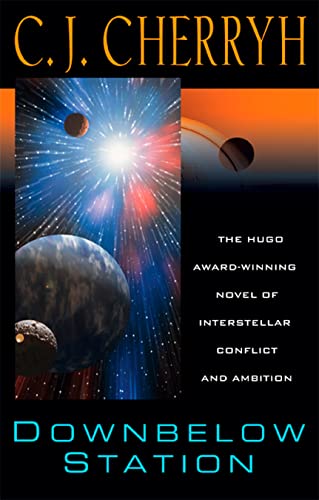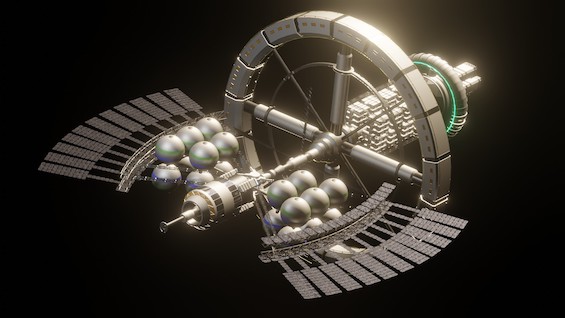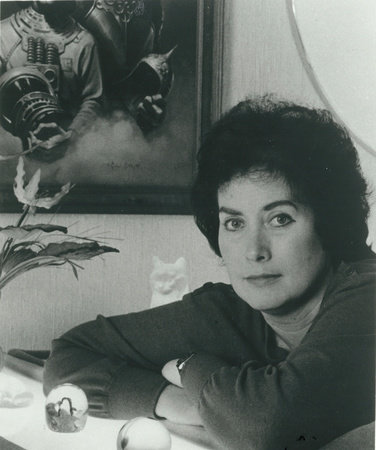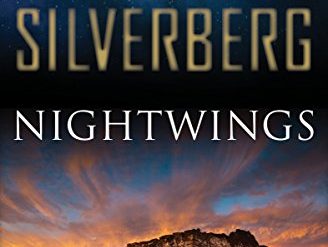
Pick up any one of those sci-fi epics with a lurid cover that promises a story of combat in space. What do you see? Probably, humans battling evil aliens resembling lizards or spiders—or something undefinable. You can be sure there’ll be lots of battles, with heroic space jockeys stressed to the limit—but always victorious in the end. Tedious, isn’t it? These novels promise a few precious hours squandered on momentary escape, but nothing more. Well, here’s a novel about interstellar war, and the only aliens in the story are an innocent sort caught between the warring sides. And there are few words wasted on battles in space resembling the showdown at the OK Corral. Because in Downbelow Station, her extraordinary Hugo-winning tale of a clash between two civilizations, C. J. Cherryh paints a picture of war in the 24th century with memorable characters who are recognizably human. And, in the end, we have a firmer grasp on the human condition.
Estimated reading time: 6 minutes
Setting the scene
In a brief introduction to the 20th anniversary edition of her novel, Cherryh explains that the eponymous Downbelow Station lies on the surface of a planet orbiting the star we know as Tau Ceti. The people of this far-future settlement know their sun as Pell. And the station that orbits their planet is, thus, Pell’s Station.
In a short opening chapter that follows the introduction, Cherryh breezes through the years from 2005 to 2352, when the action in the novel begins. Humanity spreads to the stars over this period. Most colonists live on orbiting stations like Pell’s, since habitable planets are few. “The same principles which had made Sol Station practical,” Cherryh writes, “made the first star-station viable.” We’ll learn about other stations located at far-flung locations further into the “Beyond.” One is Russell’s Station, another, Viking. There, the breakout of war forces the colonists to abandon their homes. And their arrival as desperate refugees at Pell’s Station precipitates the crisis that is at the heart of the novel.
Downbelow Station by C. J. Cherryh (1981) 528 pages ★★★★★
Winner of the Hugo Award for Best Novel

It’s all a commercial venture, based on trade among the stations
Sol Station, which orbits our sun, is owned by the powerful Sol Corporation. (Colonists will refer to it as the Earth Company, or simply the Company.) Once the process of colonization was underway, it accelerated. “Star after star after star . . . nine of them—until Pell, which proved to have a livable world, and life.” As arriving colonists learned, “the aliens of Pell’s World were not outstandingly intelligent, nor violent, built nothing, and looked more like lower primates than not, brown-furred and naked and with large, bewildered eyes.” The colonists call them Downers, after Downbelow Station. Their own term for themselves is hisa. They prove to serve willingly as laborers, so long as they’re well treated by their human overseers. And their labor proves essential in the vigorous commerce that develops, as Pell becomes a source of manufactured, Earthlike goods.
Origins of the conflict
But all was far from well in this developing interstellar civilization. First, the Earth Company imposed a tax on the goods produced at Pell and other stations—and they sent Company enforcers to collect. “Merchanters armed in retaliation, freighters never built for combat.” Soon “it became war without anyone calling it war . . . armed Company probes against the rebel merchants, who served the farther stars.” And as they spread further into the Beyond, colonists found a second habitable planet, which they named Cyteen. There, the rebel forces coalesced into the Union.
Conflict over trade evolves into war
Soon, full-fledged interstellar war broke out between the Union and the Company, which dispatched a fleet under a captain named Conrad Mazian. A war that the Company lost—”not in the Beyond, but in the senate chambers and the boardrooms on Earth and Sol Station . . . Earth banned further emigration, seeing the flight of its best minds.” And Mazian’s Fleet found itself on its own, orphaned by the Company. It was this fleet that arrived at Pell Station, shepherding flocks of “merchanter” vessels that deliver the thousands of refugees who had survived Union attacks at Russell’s and Viking Stations. “Union had the Beyond, all but the thin arc of stations which Mazian’s Fleet still thanklessly held for Earth and the Company.”
Interstellar war is short and intense in this novel
Everything I’ve written so far comes to light by the end of the first chapter. It’s all prelude. The present-tense action in Downbelow Station all takes place from May 2, 2352 to January 30, 2353—and it’s suspenseful from beginning to end. We follow events through the eyes of an expansive cast of characters. In the Fleet. On Pell’s Station. Downbelow. And among the merchanters. Cherryh does a brilliant job of holding it all together and sustaining the drama through more than 500 pages. It’s hard to imagine another novel about interstellar war that could be as convincing.
A long cast of characters
By my count eighteen characters have the equivalent of significant speaking roles in Downbelow Station. It’s difficult to sort out which of them might be called the stars of the story. But nine stand out most clearly:
- Damon Konstantin, elder son of Angelo Konstantin, stationmaster of Pell Station
- Elene Quen, sole survivor of an eminent merchant clan and wife of Damon Konstantin
- Jon Lukas, head of a family that rivals (and resents) the Konstantin family’s predominance on Pell
- Signy Mallory, captain of the jump-carrier Norway, third in seniority of Mazian’s Fleet
- Joshua Talley, a Union prisoner-of-war
- “Jessad,” a Union agent
- Vassily Kressich, a former councilor on Russell’s Station, now a refugee
- Satin-tam-utsa-pitan, a young hisa (“Downer”) female
- Bluetooth, Satin’s hisa “friend”
As you can see, Downbelow Station is a complex tale that requires close attention. It’s not a book to skim in a single sitting.
About the author

Carolyn Janice Cherry was born in St. Louis in 1942. She publishes under the name C. J. Cherryh because, when she began writing science fiction in the 1970s, the field was male-dominated. Disguising her gender made sense. And she added the “h” to her surname at the behest of the famous SF publisher Donald A. Wollheim of DAW Books because he thought the name “Cherry” sounded like a romance author. Probably also because the name “Cherryh” seems futuristic, or at least weird.
Cherryh has written more than eighty books since her first two novels saw the light in 1976. Along the way, she has garnered a long list of awards, including Hugos for two of her novels. She lives near Spokane, Washington with her wife, science fiction and fantasy author and artist Jane Fancher.
For related reading
You’ll find this book in good company at Great military science fiction.
For more good reading, check out:
- These novels won both Hugo and Nebula Awards
- The ultimate guide to the all-time best science fiction novels
- 10 top science fiction novels
- 10 new science fiction authors worth reading now
- Good books about space travel
And you can always find my most popular reviews, and the most recent ones, on the Home Page.

























